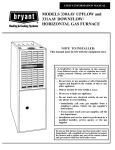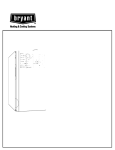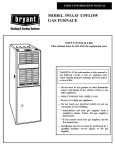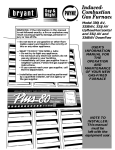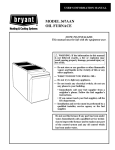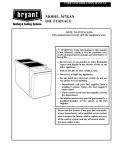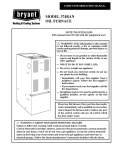Download Bryant 349HAV Operating instructions
Transcript
USER’S INFORMATION MANUAL MODEL 349HAV HORIZONTAL GAS FURNACE OFF ON a WARNING: If the information in this manual is not followed exactly, a fire or explosion may result causing property damage, personal injury or loss of life. — Do not store or use gasoline or other flammable vapors and liquids in the vicinity of this or any other appliance. — WHAT TO DO IF YOU SMELL GAS: • Do not try to light any appliance. • Do not touch any electrical switch; do not use any phone in your building. • Immediately call your gas supplier from a neighbor’s phone. Follow the gas supplier’s instructions. • If you cannot reach your gas supplier, call the fire department. — Installation and service must be performed by a qualified installer, service agency or the gas supplier. NOTE TO INSTALLER: This manual must be left with the equipment user. WELCOME TO A NEW GENERATION OF COMFORT Congratulations! Your new, 80%* efficient gas furnace is a sound investment which will reward you and your family with years of “warm memories” winter after winter. Not only is your new furnace energy efficient, it is also one of the most reliable. Spend just a few minutes with this booklet to learn about the operation of your new furnace—and the small amount of maintenance it takes to keep it operating at peak efficiency. Years went into the development of your new furnace. Take a little time now to assure its most efficient operation for years to come. * The output capacity and any representations of efficiency for this furnace are based on standard Department of Energy test procedures. OFF ON 1 MODEL 349HAV HORIZONTAL FURNACE INSTALLATION DATA SPLIT-SYSTEM Date Installed OUTDOOR UNIT: Dealer Name Product No. Address Model No. City Serial No. State Zip INDOOR COIL: Telephone Product No. FURNACE Model No. Product No. Serial No. Model No. Serial No. —2— HORIZONTAL FURNACE COMPONENTS 1 Primary serpentine heat exchanger. Stretches fuel dollars with the S-shaped heat flow design. Solid construction of corrosion-resistant aluminized steel means reliability. 2 Burner assembly (inside). Operates with energy-saving pilot, inshot burners, and hot surface igniter for safe, dependable heating. 3 Gas valve—ignition module assembly. Safe, efficient. Features 2 separate gas shutoff valves. 4 Heavy-duty blower. Circulates air, scrubbing the heat exchangers to transfer heat into the home. 5 Air filter, and wire filter retainer (optional). 6 Inducer motor. Pulls hot flue gases through the heat exchangers, maintaining negative pressure for added safety. 7 Vent outlet. Carries vent gases from the home. 8 Limit switch. Shuts furnace down in the event of an overheating condition. 9 Pressure switch. Ensures adequate flow of flue products through furnace and out vent system. 10 Control center. 9 8 7 10 6 1 OFF ON 4 2 3 5 2 MODEL 349HAV HORIZONTAL FURNACE (Unit Shown In Horizontal Left Configuration) —3— IMPORTANT FACTS Your furnace must have adequate airflow for efficient combustion and safe ventilation. Do not enclose it in an airtight room or “seal” it behind solid doors. OFF ON 3 To minimize the possibility of serious personal injury, fire, damage to your furnace, or improper operation, carefully follow these safety rules: • Keep the area around your furnace free of combustible materials, gasoline, and other flammable liquids and vapors. • Do not cover the furnace, store trash or debris near it, or in any way block the flow of fresh air to the unit. • A furnace installed in an attic or other insulated space must be kept free and clear of insulating material. Examine the furnace area when installing the furnace or adding more insulation. Some materials may be combustible. NOTE: Do not use this furnace if any part has been under water. Immediately call a qualified service technician to inspect the furnace and to replace any part of the control system and any gas control which has been under water. SAFETY CONSIDERATIONS Installing and servicing heating equipment can be hazardous due to gas and electrical components. Only trained and qualified personnel should install, repair, or service heating equipment. Untrained personnel can perform basic maintenance functions such as cleaning and replacing air filters. All other operations must be performed by trained service personnel. Observe safety precautions in this manual, on tags, and on labels attached to the furnace and other safety precautions that may apply. Recognize safety information. This is the safety-alert symbol ! . When you see this symbol on the furnace and in instructions or manuals, be alert to the potential for personal injury. Understand the signal words DANGER, WARNING, and CAUTION. These words are used with the safety-alert symbol. DANGER identifies the most serious hazards which will result in severe personal injury or death. WARNING signifies hazards which could result in personal injury or death. CAUTION is used to identify unsafe practices which would result in minor personal injury or product and property damage. STARTING YOUR FURNACE Instead of a continuously burning pilot flame which wastes valuable energy, your furnace uses an automatic, hot surface ignition system to light the pilot each time the thermostat starts your furnace. Follow these important safeguards: • Never attempt to light the pilot manually with a match or other source of flame. floor. If you smell gas, STOP! Follow “B” in the safety information above on this furnace label. If you don’t smell gas, go to the next step. • If a suspected malfunction occurs with your gas control system, such as the burners not lighting when they should, refer to the shutdown procedures on the furnace or in the next section to turn off your system, then call your dealer as soon as possible. ! WARNING If overheating occurs, or the gas valve fails to shut off the gas supply, turn off the manual gas valve (see Fig. 7) to the furnace BEFORE turning off the electrical supply. Failure to follow this warning could result in a fire or explosion, and personal injury or death. • CHECK AIR FILTER: Before attempting to start your furnace, be sure the furnace filter is clean and in place. (See the maintenance section of this manual.) Then proceed as follows: STEPS FOR STARTING YOUR FURNACE 1. Set your room thermostat to the lowest temperature setting. (See Fig. 6.) 2. Close the external manual gas valve. (See Fig. 7.) 3. Turn off the electrical supply to the furnace. (See Fig. 8.) ® 6 4 CL SE O NOTE: The qualified installer or agency must use only factory-authorized replacement parts, kits, and accessories when modifying this product. If the furnace is left unattended for an extended period of time, have it checked periodically for proper operation. This precaution will prevent problems associated with NO HEAT, such as frozen water pipes, etc. See “Before You Request a Service Call” section in this manual. 5 • Read and follow the operating instructions on the furnace, especially the item that reads as follows: Wait 5 minutes to clear out any gas. Then smell for gas, including near the —4— 7 SHUTTING DOWN YOUR FURNACE Should you ever suspect a malfunction in your furnace, you will need to turn your furnace off. The following procedures must be followed: 1. Set your room thermostat to the lowest temperature setting. (See Fig. 13.) 8 11 4. Turn the switch on the gas valve to the OFF position and wait 5 minutes. (See Fig. 9.) ® OP EN 13 OFF ON 12 9 5. After waiting 5 minutes, turn the switch on the gas valve to the ON position. (See Fig. 10.) OFF ON When room temperature drops below the temperature selected on the thermostat, the furnace will be switched on automatically. When room temperature reaches the degree selected on the thermostat, the furnace will be switched off automatically. Some thermostats have a fan mode with 2 selections: AUTO and ON. When set to AUTO, the furnace blower cycles on and off, controlled by the thermostat. In ON mode, the furnace blower runs continuously except for a 30-sec delay at the call for heat. This keeps the temperature level in your home more evenly balanced. It also continuously filters the indoor air. —5— OFF 9. The hot surface igniter will light the pilot flame. Once the pilot flame is sensed, the gas valve permits gas to flow to the main burners where it is ignited. Hot flames begin to warm the furnace’s heat exchanger. After a time delay of approximately 30 sec, the furnace blower is switched on. 10. Set your thermostat to the temperature that satisfies your comfort requirements. SUGGESTION: Setting the thermostat back a few degrees and compensating for the difference with warmer clothing can make a big difference in your fuel consumption on extremely cold days. The few degrees at the top of your thermostat “comfort level” are the most costly degrees to obtain. 14 2. Close the external manual gas valve. (See Fig. 7.) 3. Turn off the electrical power to your furnace. (See Fig. 14.) 4. Turn the switch on the gas valve to the OFF position. (See Fig. 15.) ON 10 6. Turn on the electrical supply to the furnace. (See Fig. 11.) 7. Open the external manual gas valve. (See Fig. 12.) 8. Set the room thermostat to a temperature slightly above room temperature. This will automatically signal the furnace to start. The inducer motor will start, the pressure switch will close, and the hot surface igniter will be energized. If the pilot fails to light, igniter remains energized, and pilot gas valve remains open. If this is due to a gas interruption, the system continues its attempt to light pilot until gas is restored and unit lights or system is turned off. 15 5. If the furnace is being shut down because of a malfunction, call your dealer as soon as possible. PERFORMING ROUTINE MAINTENANCE With proper maintenance and care, your furnace will operate economically and dependably. Instructions for basic maintenance are found on this and the following pages. However, before beginning maintenance, follow these safety precautions: • REMOVE THE FILTER FOR ! WARNING Turn off electrical power supply to your furnace before removing the access doors to service or perform maintenance. Failure to follow this warning could result in personal injury or death. CLEANING AS FOLLOWS: 1. Turn off electrical supply to the furnace. (See Fig. 14.) 2. Remove blower access door located at the inlet (return-air) end of the furnace (4 screws must be removed). (See Fig. 16.) ! CAUTION 17 Although special care has been taken to minimize sharp edges, be extremely careful when handling parts or reaching into the furnace. OFF ON ! CAUTION Never operate your furnace without a filter in place. Doing so may damage the furnace blower motor. An accumulation of dust and lint on internal parts of your furnace can cause a loss of efficiency. The air filter is normally located in the blower compartment before the blower. (See Fig. 17.) If the filter(s) has been installed in another location, contact your dealer for instructions. To inspect, clean, and/or replace the air filter(s), follow these steps: If your furnace filter needs to be replaced, be sure to use the same size and type of filter that was originally supplied. Use the furnace filter table and compare your furnace size with the proper filter size. HORIZONTAL FURNACE FILTER TABLE HORIZONTAL FURNACE INPUT (BTUH) 50,000 75,000 100,000 125,000 FILTER SIZE (IN.) FILTER TYPE (1) 13 x 23 x 1/2 Cleanable (1) 13 x 23 x 1/2 Cleanable (1) 16-1/2 x 23 x 1/2 Cleanable (1) 20 x 23 x 1/2 Cleanable OFF A dirty filter will cause excessive stress on the furnace blower motor and can cause it to overheat and automatically shut down. The furnace filter should be checked every 3 or 4 weeks and cleaned if necessary. ON FILTERING OUT TROUBLE (Optional Accessory) 16 3. Bend the formed wire filter retainer to clear the furnace flange at 1 side. 4. Pivot the filter retainer toward the blower. (See Fig. 17.) 5. Remove the filter from the furnace. 6. Inspect the filter. If torn, replace it. 7. Wash the filter (if dirty) in a sink, bathtub, or outside with a garden hose. Always use cold tap water. A mild liquid detergent may be used if necessary. Spray water through the filter in the opposite direction of airflow through the cross-mesh binding side. Allow filter to dry. 8. Reinstall the clean filter with the cross-mesh binding side facing the furnace blower. 9. Replace blower door, reinstall 4 screws (see Fig. 18), and turn on electrical power to your furnace. 18 ! CAUTION If your furnace makes an especially loud noise when the main burners light, shut down your furnace and call your dealer. To inspect the combustion area and vent system, you will need a flashlight. Refer to Fig. 2, and proceed as follows: 1. Turn off the electrical supply to your furnace. (See Fig. 14.) 2. Remove burner enclosure front. Inspect the gas burners for dirt, rust, or scale. (See Fig. 19.) Then inspect the vent outlet area and vent pipe. COMBUSTION AREA AND VENT SYSTEM Visually inspect the combustion area and vent system before each heating season. Make sure that the pipe leading into the vent is free from any cracks and sags. Also check the vent pipe on the outside of your home for blockage. When dirt, soot, or rust is allowed to build up, your furnace can suffer a loss of efficiency and perform improperly. Accumulations on the main burners can result in their firing out of normal sequence. This delayed ignition will create an alarmingly loud sound. —6— 19 ! CAUTION If dirt, rust, soot, or scale accumulations are found, call your dealer. Do not operate your furnace. 3. Inspect the vent pipe for sags, holes, cracks, or disconnections. Any horizontal vent pipe must slope upward, away from the furnace. If rusty joints or seams, or signs of water leakage are found, call your dealer for service. problems, have a trained service specialist give your furnace a professional check-up annually. The following checklist can be used as a guideline to proper service: • Inspect all flue gas passages, burners, heat exchangers, and inducer assembly. • Inspect all combustion and ventilation ! DANGER If holes are found in the vent pipe, or if it has become disconnected, toxic fumes can escape into your home. DO NOT OPERATE YOUR FURNACE. Call your dealer for service. 4. Reinstall the burner enclosure front. 5. If your furnace is free of the above conditions, restore electrical power to your furnace. (See Fig. 11.) 6. Start your furnace and observe its operation. Watch the burner flames to see if they are clear blue, almost transparent. (See Fig. 20.) If you observe a suspected malfunction, or that the burner flames are not clear blue, call your dealer. air passages and openings, including vent pipe terminations outside the structure. • Check gas pipes leading to and inside of your furnace for leaks. • Inspect, clean, and lubricate the blower motor and wheel as required. NOTE: If oil ports are provided, refer to the unit Service and Maintenance Instructions for blower motor oiling information. The motor must be oiled by a qualified service technician. • Inspect and change or clean air filter(s) if necessary. • Inspect all supply- and return-air ducts for obstructions, air leaks, and insulation. Remedy any problem when necessary. • Inspect electrical wiring, connections, and components for loose connections. • Perform an operational checkout to determine whether your furnace is working properly and if it requires adjustments. • Examine the physical support of the furnace; the support should be sound with no cracks, sagging, gaps, etc. around the base. • Check the furnace for any obvious signs of deterioration. 20 A CHECKUP CHECKLIST Your furnace represents an important investment in your family’s comfort and your home’s value. To keep it in tip-top shape and as a preventative to future • Your servicing dealer offers an economical service agreement that covers seasonal inspections; ask for details. BEFORE YOU REQUEST A SERVICE CALL If your furnace is not operating or not performing properly, you may save the ex- —7— pense of a service call by checking a few things yourself before calling for service. FOR INSUFFICIENT AIRFLOW: • Check for dirty air filter(s). • Check for blocked return-air or supplyair grilles throughout your home; ensure they are open and unobstructed. If problem still exists, call your dealer for service. IF FURNACE FAILS TO OPERATE: Follow this checklist step by step, advancing to the next 1 only if furnace fails to start. • Check thermostat for proper temperature (set above room temperature). • Is the thermostat set on HEAT? • Check fuses and circuit breakers. Is the electrical supply on? • Is the manual shutoff valve in gas s upply pipe in open position? (Follow start-up procedures if you open gas valve.) NOTE: Turn off the electrical power supply before continuing with checklist. • Is the control knob on gas valve in ON position? (Follow start-up procedures if you must reset knob to ON.) • Check the manual-reset flame rollout switch located on the burner assembly. (See Fig. 2.) If the furnace has experienced high temperature conditions, this switch will shut off the furnace. Reset it by pushing the button on the switch. If it trips again, shut down the furnace and call for service. See “Shutting Down Your Furnace” section in this manual. • Check for obstructions around the vent termination. If your furnace still fails to operate, call your service representative. For your convenience, record the product and serial numbers on the form on page 2. Should you ever require service, you will have ready access to the information needed by the service representative. Cancels: OM04-26 © 1998 Bryant Heating & Cooling Systems, 7310 W. Morris St. Indpls., IN 46231 —8— PRINTED IN U.S.A OM04-31 Catalog No. 5334-902 6-98








